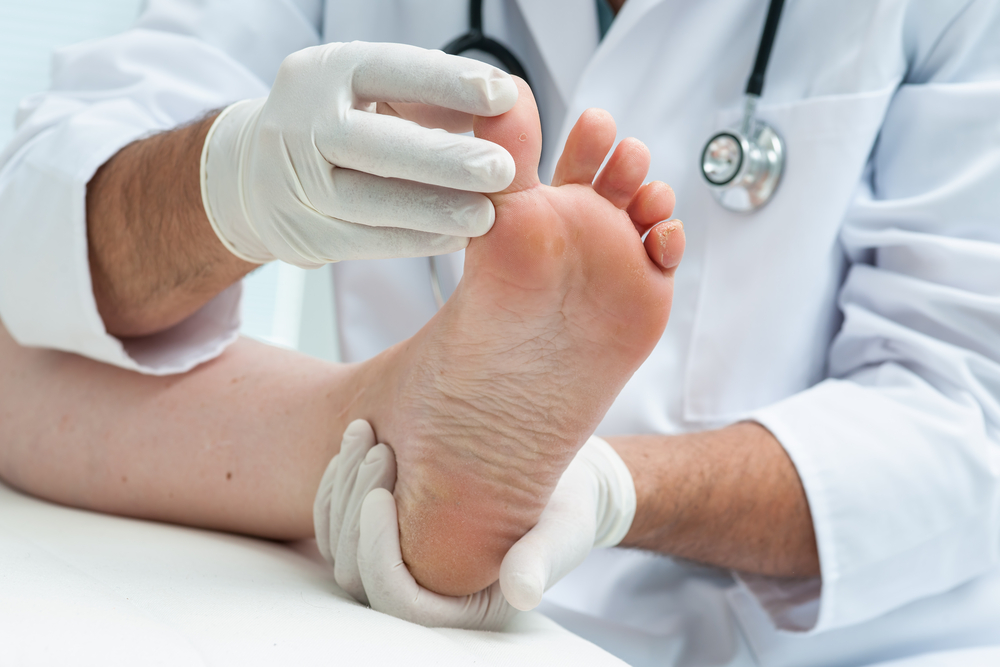Athlete’s foot is an extremely common fungal infection that can affect the feet. Many people will suffer from it at some point in their lives. Here at Island Foot Clinics in Kelowna, we are often asked if treatment is necessary, or will the infection go away on its own?
Will Athlete’s Foot Go Away on Its Own?
This type of fungal infection does not usually cause any serious problems in healthy people. However, it does not usually clear up on its own, and if left untreated, it can spread to other parts of the body, including the hands, nails, and even the groin. Additionally, if left untreated, the infection can worsen, and painful fissures can develop as a result. These cracks in the skin make the feet vulnerable to bacterial infections, further complicating the healing process.
What Is It?
This is a common fungal infection that affects the upper layer of the skin on the foot. Also known as tinea pedis, it usually begins between the toes. Despite its common name, it does not only affect athletes. This infection is closely related to ringworm and jock itch. The majority of cases are caused by a type of fungi called dermatophytes that usually live harmlessly on dry, clean human skin.
These fungi feed on a protein called keratin, found in nails, skin, and hair. In warm and damp conditions, these fungi begin to thrive, multiplying rapidly, leading to this fungal infection.
Causes
As already discussed, in order to thrive and multiply, this type of fungi needs moisture and warmth. It most commonly occurs when the feet have become sweaty, dampening the socks and shoes they are confined in. Tinea pedis gets its more common name because the feet of athletes and gym-goers are much more likely to encourage this type of environment. Thick, tight shoes are more likely to trigger this condition as they squeeze the toes together and do not allow air to circulate.
Plastic shoes have shown to be most likely to encourage infection as they are far less breathable than other materials like canvas or leather, leading to the warming and moistening of the feet. In any case, if for any reason the socks are damp and the feet warm, the individual poses a greater risk of developing tinea pedis.
Risk Factors
There are certain factors that can further increase the risk of tinea pedis. It can be genetic, so those with susceptible family members are more at risk. People who suffer from certain allergies, eczema, or particularly sweaty feet. Those with a weakened immune system and those with narrowed blood vessels, diabetes, or other circulation problems.
Is It Infectious?
It can be very infectious and can be spread through both direct and indirect contact. It can be spread directly via skin-to-skin contact with other people or by touching other parts of the body, passing it to areas like the hands, groin, toenails, or other foot. Indirectly, the infection can be spread via contaminated surfaces, towels, bedsheets, socks, shoes, and clothing. It is commonly spread in contaminated places that are humid and warm, like swimming pools and communal showers.
Symptoms
Tinea pedis can occur on one or both feet, and it typically begins between the toes. Sufferers may notice an itchy, scaly red rash. It may also feel like it is causing burning or a stinging sensation. The skin may thicken and crack or turn white and flaky. There may also be small red blisters between the toes or on the soles of the feet. These blisters, ulcers, or sores can leak fluid, smell bad, and look red.
If symptoms occur across the sole of the foot, it may be referred to as moccasins foot. Although it is the same infection, it can sometimes be mistaken for eczema. The sole of the foot is most commonly affected by ongoing dryness and scaling that can also occur on the sides of the foot. It can also spread to your toenails, turning them dull and yellow. They may also appear unusually thick.
Prevention
If you are worried about developing or catching tinea pedis, there are certain things you can do to reduce the risk of infection. The most important factor is to keep your feet dry. This can be achieved by thoroughly drying your feet after showering, bathing, or swimming. Avoid shoes that are too tight or do not allow any air to circulate. Remove shoes as much as possible, especially in warmer environments, and by wearing moisture-wicking socks.
There are a number of ways you can help prevent indirect contamination. Avoid sharing towels, socks, and shoes with others, and wash these items and bedsheets at high temperatures. Wear flip flops or swim socks in swimming pools, communal changing rooms, and showers. Lastly, keep good foot hygiene by washing the feet daily with soap and water, making sure to wash in between the toes, and then thoroughly drying.
How Is It Diagnosed?
In many cases, a health professional can usually diagnose the infection by looking at the signs and symptoms presented. In some cases, to help rule out other conditions, a skin scraping or skin sample may be taken and tested.
Treatment
For mild cases, your podiatrist or doctor may advise using over-the-counter anti-fungal treatment, such as an ointment, cream, gel, powder, or spray. Some people use home remedies such as tea tree oil. However, there is no scientific proof that they are effective in treating this type of fungal infection.
How Can a Podiatrist Help?
You can schedule an appointment with a podiatrist as soon as you notice any signs of tinea pedis. If you choose to tackle the problem yourself using over-the-counter treatments, you should visit a podiatrist or doctor if the symptoms show no sign of healing after two weeks. You should see your podiatrist or doctor immediately if your symptoms are anything more than mild, if the infection has spread, or if the rash has turned into sores.
Podiatrists are able to prescribe fast-acting treatments that will quickly attack the fungus and stop it from spreading. They will work with you to determine the cause of the infection and rule out any further or separate issues. They will also help to ensure the infection does not return by providing knowledge and information regarding your personal circumstances.
Common Myths
- It only affects athletes – False
- It will heal on its own – False
- It is down to poor hygiene – False
- It is not contagious – False
- It can’t be spread via skin-to-skin contact – False
- You can only get it by walking barefoot in infected areas – False
- Wearing shoes and socks prevents infection – False
- Treatment can stop once symptoms disappear – False
- Once treated, it will never return – False
- It only affects the feet – False
- Home remedies and over-the-counter treatments work no matter how severe – False
If you are worried you may have athlete’s foot, would like to learn more about the condition, or have any other concerns regarding your feet, call or visit us at Island Foot Clinics Podiatry Group. We have clinics in Kelowna, Nanaimo, Victoria, Campbell River, Prince George, Terrace, Williams Lake, and many other communities in British Columbia.

